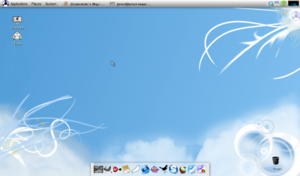Aurora OS (Eeebuntu)
 | |
| OS family | Linux (Unix-like) |
|---|---|
| Working state | Discontinued |
| Source model | Open source |
| Final release | 3.0 / 15 May 2009 |
| Available in | English |
| Update method | APT (front-ends available) |
| Package manager | dpkg |
| Platforms | x86 |
| Kernel type | Linux |
| Default user interface | GNOME (+ Ubuntu Netbook Edition for NBR version) |
| License | Mainly the GNU GPL / Various others |
| Official website | www.auroraos.org |
Aurora (formerly Eeebuntu) is a discontinued[1] operating system for netbooks. The latest version is based on Ubuntu, though newer versions were planned to be based on Debian Unstable.[2] Eeebuntu was designed originally for the Asus Eee PC line of netbooks.
Four versions are available for installation: Standard, NBR (standard with Ubuntu Netbook Edition), Base and LXDE.
Features
[edit]- Works out of the box on Asus Eee PC 700, 701, 900, 900A, 901, 904HD, 1000, 1000H, 1000HA, 1000HD and 1000HE, with recent versions also supporting the Acer Aspire One A110L.[citation needed]
- Includes an Asus Eee PC specific kernel which is tuned for Eee's hardware (e.g., Wi-Fi module, function keys).[3]
- VLC, Flash and Java installed out of the box.[3]
- Can create a bootable USB stick or SD card using UNetbootin.[citation needed]
- Integrates the eeepc-tray ACPI (now changed to Jupiter) utility to control ACPI events and toggle certain devices on the Eee on/off.[citation needed]
History
[edit]Eeebuntu was created in December 2007 by Steve Wood. At that time,[when?] Eeebuntu was little more than a collection of scripts applied to a live Ubuntu image. As the project matured,[when?] the post-install scripts were dropped in favour of a modified kernel that contained pre-compiled hardware drivers.[citation needed]
Other developers took interest in the project, and by December 2008, Eeebuntu had grown into a Linux distribution in its own right,[dubious – discuss] with around 1,300 registered forum users.[4] Eeebuntu 2.0 was the first Eeebuntu version to completely remove Ubuntu branding and use its own artwork and themes.[citation needed]
With the expanded interest in Eeebuntu as a distro for numerous netbooks (beyond its namesake Asus Eee PCs), support was expanded to multiple netbooks with new kernel changes and drivers.[citation needed]
In 2008,[citation needed] other notable members[which?] of the leadership joined the project. Such members include Paul McDonough, who was responsible for the kernel patching, packaging, design, and promotion of Eeebuntu, thereby allowing Steve and other contributors to focus on development of new capabilities. Work was done alongside other notable distributions at the time, such as elementary OS,[citation needed] to share FOSS code and provide improvements such as optimised versions of the Nautilus file manager and other applications in the base system of Eeebuntu 3.0.[citation needed]
Eeebuntu has 4 versions:
- Base - 565MB ISO footprint, reduced number of pre-installed applications.
- Standard - A compiz-enabled full desktop with a number of pre-installed applications.
- NBR - Using the Ubuntu Netbook interface with a number of pre-installed applications.
- LXDE - Utilising the LXDE desktop and a number of pre-installed applications.
Eeebuntu 3.0 release
[edit]The 3.0 release of Eeebuntu is based on Ubuntu 9.04.[5] It addresses a number of issues with the integrated Intel graphics cards and provides Eee PC specific optimization.[6]
Major changes to the approach of Eeebuntu's release saw rapid adoption with over 800,000 downloads and resulted in this version being awarded the Sourceforge Community Choice award for best new project in 2009.[7]
See also
[edit]References
[edit]- ^ "Aurora OS". DistroWatch.com. Retrieved 26 July 2024.
- ^ Eeevolution - Eeebuntu 4.0 and beyond Archived July 26, 2011, at the Wayback Machine
- ^ a b Best netbook-friendly Linux distros Archived July 21, 2009, at the Wayback Machine
- ^ "Index page". eeebuntu. Archived from the original on 2008-12-22. Retrieved 26 July 2024.
- ^ Linder, Brad (22 May 2009). "Eeebuntu 3.0 Base Linux distro for Eee PC now available". Liliputing. Retrieved 26 July 2024.
- ^ EEEBUNTU 3.0 REVIEW Archived March 28, 2010, at the Wayback Machine
- ^ Interview with Sourceforge choice award winner, Eeebuntu 3.0's Paul McDonough
External links
[edit]| General | |||||||||
|---|---|---|---|---|---|---|---|---|---|
| People | |||||||||
| Derivatives |
| ||||||||
| Software |
| ||||||||
| Technology and user interface |
| ||||||||
| Hardware | |||||||||
| Support |
| ||||||||
| Fonts | |||||||||
| Media | |||||||||
| Related topics | |||||||||
| Android | |||||||||||||
|---|---|---|---|---|---|---|---|---|---|---|---|---|---|
| Arch | |||||||||||||
| Debian |
| ||||||||||||
| Fedora | |||||||||||||
| Gentoo | |||||||||||||
| Mandriva | |||||||||||||
| Slackware | |||||||||||||
| SUSE | |||||||||||||
| Other | |||||||||||||
| Discontinued |
| ||||||||||||
Text is available under the CC BY-SA 4.0 license; additional terms may apply.
Images, videos and audio are available under their respective licenses.

